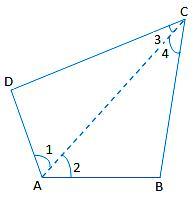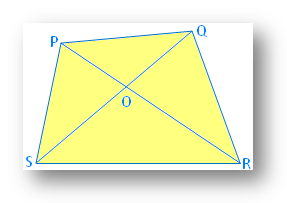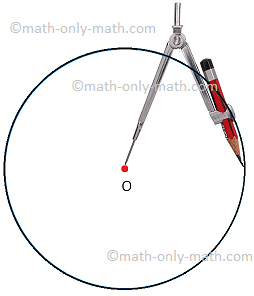Angle Sum Property of a Quadrilateral
Theorem and Proof of angle sum property of a quadrilateral.
Prove that the sum of all the four angles of a quadrilateral is 360°.
Proof: Let ABCD be a quadrilateral. Join AC.
Clearly, ∠1 + ∠2 = ∠A ...... (i)
And, ∠3 + ∠4 = ∠C ...... (ii)
We know that the sum of the angles of a triangle is 180°.
Therefore, from ∆ABC, we have
∠2 + ∠4 + ∠B = 180° (Angle sum property of triangle)
From ∆ACD, we have
∠1 + ∠3 + ∠D = 180° (Angle sum
property of triangle)
Adding the angles on either side, we get;
∠2 + ∠4 + ∠B + ∠1 + ∠3 + ∠D = 360°
⇒ (∠1 + ∠2) + ∠B + (∠3 + ∠4) + ∠D = 360°
⇒ ∠A + ∠B + ∠C + ∠D = 360° [using (i) and (ii)].
Hence, the sum of all the four
angles of a quadrilateral is 360°.
Solved examples of angle sum property
of a quadrilateral:
1. The angle of
a quadrilateral are (3x + 2)°, (x – 3), (2x + 1)°, 2(2x + 5)° respectively.
Find the value of x and the measure of each angle.
Solution:
Using angle sum property of quadrilateral, we get
(3x + 2)°+ (x – 3)° + (2x + 1)° + 2(2x + 5)°= 360°
⇒ 3x + 2 + x - 3 + 2x + 1 + 4x + 10 = 360°
⇒ 10x + 10 = 360
⇒ 10x = 360 – 10
⇒ 10x = 350
⇒ x = 350/10
⇒ x = 35
Therefore, (3x + 2) = 3 × 35 + 2 = 105 + 2 = 107°
(x – 3) = 35 – 3 = 32°
(2x + 1) = 2 × 35 + 1 = 70 + 1 = 71°
2(2x + 5) = 2(2 × 35 + 5) = 2(70 + 5) = 2 × 75 = 150°
Therefore, the four angles of the quadrilateral are 32°, 71° 107°, 150° respectively.
2. In a quadrilateral PQRS, PQ + QR + RS + SP < 2 (PR + QS).
Solution:
In ∆POS, PO + OS > PS …………… (i)
In ∆SOR, SO + OR > SR …………… (ii)
In ∆QOR, QO + OR > QR …………… (iii)
In ∆POQ, PO + OQ > PQ …………… (iv)
(i) + (ii) + (iii) + (iv) (Using triangle inequality property)
PO + OS + OS + OR + OQ + OR + OP + OQ > PS + SR + QR + PQ
⇒ 2 (OP + OQ + OR + OS) > PQ + QR + CS + DP
⇒ 2 [(OP + OR) + (OQ + OS)] > PQ + QR + CS + DP
⇒ 2 (PR + QS) > PQ + QR + RS + SP
The above examples will help us to solve various types of problems based on angle sum property of a quadrilateral.
7th Grade Math Problems
8th Grade Math Practice
From Angle Sum Property of a Quadrilateral to HOME PAGE
Didn't find what you were looking for? Or want to know more information about Math Only Math. Use this Google Search to find what you need.
Recent Articles
-
Dividing 3-Digit by 1-Digit Number | Long Division |Worksheet Answer
Apr 24, 24 03:46 PM
Dividing 3-Digit by 1-Digit Numbers are discussed here step-by-step. How to divide 3-digit numbers by single-digit numbers? Let us follow the examples to learn to divide 3-digit number by one-digit nu… -
Symmetrical Shapes | One, Two, Three, Four & Many-line Symmetry
Apr 24, 24 03:45 PM
Symmetrical shapes are discussed here in this topic. Any object or shape which can be cut in two equal halves in such a way that both the parts are exactly the same is called symmetrical. The line whi… -
Mental Math on Geometrical Shapes | Geometry Worksheets| Answer
Apr 24, 24 03:35 PM
In mental math on geometrical shapes we will solve different type of problems on simple closed curves, polygons, basic geometrical concepts, perpendicular lines, parallel lines, circle, terms relates… -
Circle Math | Terms Related to the Circle | Symbol of Circle O | Math
Apr 24, 24 02:57 PM
In circle math the terms related to the circle are discussed here. A circle is such a closed curve whose every point is equidistant from a fixed point called its centre. The symbol of circle is O. We… -
Fundamental Geometrical Concepts | Point | Line | Properties of Lines
Apr 24, 24 12:38 PM
The fundamental geometrical concepts depend on three basic concepts — point, line and plane. The terms cannot be precisely defined. However, the meanings of these terms are explained through examples.






